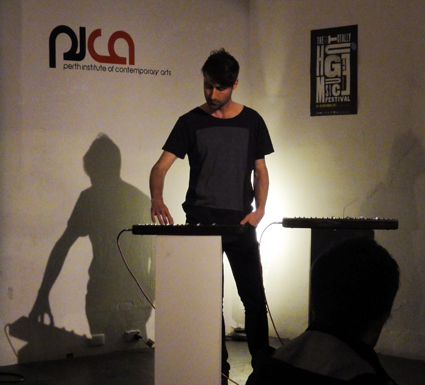the proximity of sounds
sam gillies: club huge #1: marina rosenfeld and julian day, thnmf

Julian Day, Club Huge #1
photo Gail Priest
Julian Day, Club Huge #1
FOLLOWING THE VIRTUOSIC PERFORMANCES OF ROSS BOLLETER, MARK GASSER AND ANTHONY PATERAS AT THE PIANO TAPESTRIES PERFORMANCE, A SMALL GROUP OF NEW MUSIC ENTHUSIASTS RETIRED TO THE PICA BAR FOR CLUB HUGE #1, SOMETHING OF AN AFTER PARTY FOR TURA’S MAIN PRESENTATION THAT EVENING. THERE, MARINA ROSENFELD AND JULIAN DAY PERFORMED STRIPPED BACK, ELECTRONIC PERFORMANCES.
Julian Day’s set was of a continuation of his synth drone project, An Infinity Room (or AIR for short). This has included up to 30 separate synthesisers, but tonight was reduced to two with each synthesiser connected to a separate speaker. Using large metal bolts to continually sustain notes, Day manipulated thick six-note chords, one note at a time, gliding from synth to synth, his minimal gestures creating maximal results.
Exploring various approaches to the manipulation of drones makes up a large part of Day’s composition practice, something that has been clearly realised with his AIR project. In this context, Day is able to construct tension and release through slight adjustments in the chords, generating beat frequencies and other psychoacoustic effects by creating clusters of notes close to one another. While the initial addition of a note stands out, it is quickly absorbed back into the larger sound mass. At the same time the removal of a note before it is replaced creates a noticeable gap in the chord bringing abscence to the foreground.
The PICA bar space offered a unique experience of the music. While sound filled the space, rather than being particularly reverberant some areas of the room were successful bass traps which gave the work a nice, inadvertent interactive element. By and large however, much of the audience was content to remain seated in a fixed location. While the set was too loud for some, others were content to bow their heads in a kind of monastic reverence for the 25-minute duration.
Following a brief intermission, New York artist Marina Rosenfeld performed a 25-minute turntable-based set. Rather than using pre-existing recordings of other people’s sounds, Rosenfeld transfers her own pre-recorded sounds to acetate records. This gives the samples a different sound quality from traditional vinyl, which is fully exploited as a unique musical characteristic.
Compared to Day’s, Rosenfeld’s set was a decidedly minimal affair, with rhythmic clicks and bursts of noise playing against gentle, evolving tones. Unfortunately the noise of Perth’s Friday night Northbridge clientele imposed itself on what was otherwise a more meditative set.
Rosenfeld occasionally built up several layers of intensity but the more remarkable element of her performance was how willing she was to use space between her sounds. While Julian Day’s performance maintained a consistent intensity, Rosenfeld was able to incorporate space and dynamic nuance into her performance, placing an emphasis on the relationship between different sounds. Bass tones were used sparingly, almost more to add emphasis in certain places and to remind the audience that a fair proportion of the music consisted of mid and high-ranged sounds. This interplay between samples embedded the entire set with a sense of gravity and significance, the result of which was an engaging performance that brought the evening to a surprisingly introspective end.
Overall Club Huge #1 was the perfect response to the intense, virtuosic nature of the earlier Piano Tapestries concert. After the breakneck performances of Mark Gasser and Anthony Pateras, a couple of hours of laid-back, minimal electronic music from Julian Day and Marina Rosenfeld was exactly what was needed to clear the head.
Totally Huge New Music Festival 2011: Club Huge #1 – Marina Rosenfeld and Julian Day; PICA Bar, PICA, presented by Tura New Music, Sept 16; http://www.tura.com.au/totally-huge-music-festival/about
RealTime issue #106 Dec-Jan 2011 pg. 37






